A greenhouse is a place of magic. Out of its gentle climate come plants never before known in the history of the world. Sweet Sue, the impatiens shown with its parents shown, is such a one. Its color is dazzling, its variegated foliage is handsome, it duplicates itself from seeds, and in a warm, humid greenhouse it flowers all year long without pause.
Sweet Sue is a new flower in the giant family of impatiens, which grow wild in scattered parts of Asia, Africa, North and Central America and the South Pacific. It’s the swan offspring of ugly duckling parentage. On one side was a species introduced from the Celebes Island east of Borneo. From it botanists developed a variety called Tangerine, with vivid blossoms but unfortunately awkward, spindly stems. The possibility of breeding out Tangerine’s deficiencies arose in 1970, when American plant hunters returned from New Guinea with new stock, 25 impatiens of diver gent colors, shapes and growing habits. Toru Arisumi, a botanist at the U.S. Department of Agriculture’s florist and nursery crop labo ratory at Beltsville, Maryland, promptly set about making crosses between them. After about six months, the offspring were ready for re-crossing. With every generation the number of Arisumi’s plants increased, spilling over from one greenhouse to a second, while he scrutinized each new plant for its vigor, compactness, foliage pat tern, petal texture, and form and color of blossom. After five years he found one that seemed worthy to mate with Tangerine.
The glowing 2- to 2 1/2 -inch flowers and variegated foliage of greenhouse-hybridized impatiens Sweet Sue are the product of a cross between the straggly Tangerine, rear, and the compact New Guinea hybrid, left.
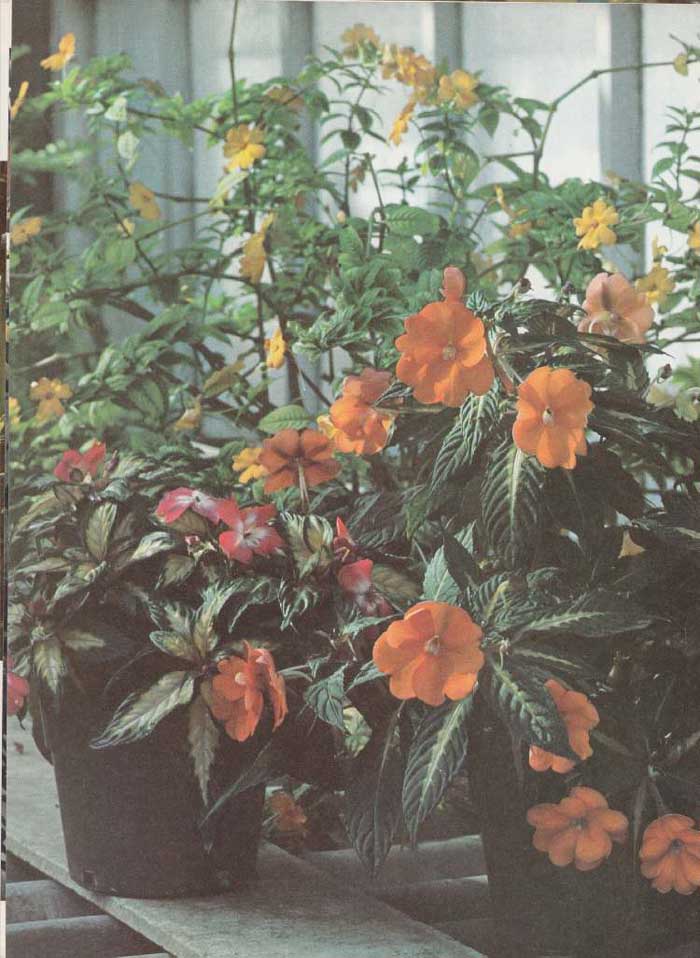
= = = =
SHAKING MUMS TO SIZE
Greenhouse gardeners who want to keep their plants compact can profit from recent experiments at Purdue University. Horticulturists there found a novel way to stunt the growth of plants such as chrysanthemums, and force them into attractive bushy shapes. By shaking the top of a chrysanthemum stem sideways 30 seconds a day for eight weeks they reduced its height by 25 per cent; marigolds were 30 per cent shorter, tomatoes 50 per cent. Soybeans responded simply to touch: a finger placed on top of the soybean’s stem twice a day for 30 seconds stunted its height in one week by 61.6 percent.
= = = =
The odds that two plant parents will pass along only their virtues are so small as to defy calculation. Yet Arisumi succeeded on the first try. The result was Sweet Sue. It was a sensation among fellow scientists but, like many crosses between species, completely sterile. Arisumi might have stopped there, since sterile plants can be propagated by cuttings. But he wanted a flower that any greenhouse owner could grow from seed. To restore the plant’s fertility, he treated it with the drug colchicine, which also made the flowers even bigger and more vivid. Finally, to ensure that the seeds of each Sweet Sue plant would produce seedlings true to their parent, he fertilized it with its own pollen (a process called selfing) until his final selections bred true and uniform.
For all his years of effort, Arisumi’s excitement when he later spoke of the hybrid still broke through his veil of scientific detachment. “I won’t pretend I’m not pleased,” he said. Arisumi’s modesty is typical. The French hybridizer, Francis Meilland, creator of the famous Peace rose, wanted something even better. “It’s all right,” he said, “but a little stingy in the bloom.”
An achievement like Peace or Sweet Sue is a triumph of highly trained botanists, often working with sophisticated laboratory equipment, chemicals and techniques beyond those available to the amateur. And yet every greenhouse owner can share in that excitement. In the controlled climate of a greenhouse you can grow practically anything in existence—by controlling the light, heat and humidity of this indoor world. You can start such gems as edelweiss from seed. You can grow many glamorous exotics from cuttings. You can graft lilacs onto young ash trees or privets. If you see an outstanding camellia or fuchsia, you need only make a few stem cuttings for rooting. For propagating the rare and unusual plant the greenhouse greatly increases the chance of success.
Many greenhouse owners go beyond cultivation of the exotic to challenge the professionals at plant breeding. In America there are thousands of such hybridizers, producing every year an un countable assortment of new irises, lilies, gloxinias, African violets, orchids, calceolarias and many others. Nearly a thousand new day lilies alone are introduced each year, and there are more than 15,000 officially named varieties.
The special reward of hybridizing is the privilege of naming the variety. Louise Koehler, a farm woman of Bixby, Minnesota, looked for a fresh interest after her children were grown. She had long admired the wild michiganense lilies that bloomed in the waste areas around her farm. With plants from a nearby lily grower, she started making crosses, and in 1968 produced a winner: a vigorous, gracefully arching plant with a profusion of white blossoms, each petal delicately re-curved. Friends insisted that she call it Louise, and it was introduced to the market where it met with acclaim.
A NEED FOR PATIENCE
Successful hybridization calls for more than tinkering. You must keep careful records, logging in every cross as well as labeling seeds and the resulting seedlings. Only that way can you establish a plant’s ancestry and note promising (or unpromising) directions for future work. You need patience. Orchid hybridizers may wait for six years or more for a cross to bloom. Daffodil breeders have a seven-year wait. Rose breeders must wait three years and longer, since roses don’t produce their true blossoms during the first year. And you must keep abreast of what other hybridizers have done, so you don’t duplicate an existing plant.
One amateur hybridizer of gloxinias began after seeing them at a flower show. “I had never seen Sirinirigia before,” she reported, “and I bought one of each kind they had—a total of two. When I put them in my greenhouse, it seemed only natural to wonder what it would be like to cross them.” The cross was made, between S. pusilla and S. canescens. The flower that resulted was splendid. But investigation revealed it was Pink Imp, a cross made earlier, registered, and well known to gloxinia growers.
“I was chagrined, to say the least,” the hybridizer said. “I didn’t even know that plant stud books existed; I had never thought of a plant as a stud before. The successful cross was pleasing, of course, but it’s more fun to be first with a new plant. Now I study the stud book.” Plant societies can direct you to libraries where such stud books can be found. You also need to know the basic laws of genetics and something of the ancestry of the plants you are working with. If the parents used in a cross are each inbred—that is, not themselves hybrids—every seedling resulting from that cross will be identical. These are known as Fl hybrids, the “F” for filial, the “1” for first generation. Such plants are often more vigorous in growth, size of flower, productiveness and other characteristics than either of their parents, especially if the parents were quite unlike each other. This is the hybrid vigor that seed catalogues extol.
RESULTS OF A SECOND CROSS
However, if these Fl hybrids are then crossed for a second generation, F2, their characteristics recombine and the resulting seedlings will differ wildly. For this reason the F2 generation is often called the segregating generation. All of the characteristics of the grandparents have separated and recombined in a great reshuffling of the plants’ ancestry. New features show up that were not at all apparent in the F1 generation, much as an aunt’s red hair might turn up in one of her niece’s children although none of her nieces or nephews had red hair. This will be true whether the parents are a single variety that is self-pollinated, or “selfed”; a parent mated with its own offspring (back-crossed); or two offspring from the previous cross that are “sibling-crossed,” or “sibbed.”
Since the first cross produces a fine new plant only in such exceptional cases as Sweet Sue, hybridizers depend largely on the egregating generation to lead them to the desired prize. Here numbers become important. The more seedlings you grow from the F2 generation, the more combinations of characteristics you will see, and the more chance you have to find the unusual feature for future breeding. Many of these plants will be inferior to those of the F 1 generation, but you may find a truly superior plant. The segregating generation is a roll of genetic dice on a grand scale.
Because space is so precious in a greenhouse, hybridizers begin to “rogue out” inferior plants as soon as possible, eliminating those with misshapen leaves, weak growth or muddy flower colors.
The danger of mix-ups is great. You must immediately tag every plant used with the name of the male and female parents and the date of the cross, marking wooden sticks with an indelible pencil. Add a number for cross reference to your notebook. Under the same number, record the rest of the parent plants’ heritage as you know it, plus other relevant information.
To keep things straight, one hybridizer writes the identities and numbers on seedling stakes before she begins. She places each of these underneath the container she is working with.
HOW TO CROSS PLANTS
The mechanics of hybridizing are simple. Remove the petals and the stamens, the slender pollen-bearing male organs, from the female parent. Then use a small, soft artist’s brush to dab pollen from the male parent—picking it up from the anthers at the top of the stamens—onto the sticky stigma at the top of the central pistil of the female plant. Finally, if there is any chance that other pollen might reach that stigma, cover it with a bag. Be sure to label both parents. When the seeds have ripened, collect them for planting.
If you are crossing two varieties of one species, your chance of success is high. When two species within one genus are crossed, you have a smaller but still reasonable chance of producing a hybrid. A successful cross between two genera is rare.
Day lilies respond well to such crossing, and are popular among amateur breeders. The procedure starts in an outdoor bed of day lilies. Early on a summer morning, strip off the anthers of a flower of the plant you choose to be the female or pod parent. Then, using an anther from the selected male parent, rub pollen onto the stigma of the female. Label a tag with the pod parent listed first and the pollen parent second, add the date, and attach it to the stalk. Record the same information in your notebook.
In 42 days the pod will ripen and, if it’s average, will contain 10 seeds. Remove the seeds from the pod, wet them in a glass of water containing a fungicide, place them in a small plastic bag containing moist peat moss or vermiculite, and store them in a refrigerator (but not in the freezing compartment). After six weeks of this cold storage, the seeds will germinate as rapidly as if they had spent all winter in the ground outside; one hybridizer reported 80 per cent germination within two days after planting.
GLOXINIA EXPERIMENTING
Miniature gloxinias are another good choice for hybridizing in a home greenhouse. They don’t take up much space, and, like other gesneriads, they are susceptible to some crossing at the genus and species level as well as between varieties, increasing beyond count the possible combinations waiting.
To cross miniature gloxinias, select two desirable plants. Just before a flower of one of them opens, use a needle to make a vertical slit down the side of the bud. Gently peel away the petals without disturbing the pistil inside or the tiny pollen-bearing stamens that surround its base. Use manicure scissors to clip off the stamens and their anthers, so the plant cannot self-pollinate; the stamens are smaller than an eyelash but easy to see. What remains is the stigma; when it becomes sticky, it’s ready for pollination. From the other parent, pick a flower, fold back the petals, and dab the anthers onto the exposed stigma. The dustlike pollen will cling.
After the seed pods form and ripen—they will be about the size of peas and will turn from light green to soft brown—harvest the hybrid seed. Slip a small envelope over the pod and snip the stem, letting the pod drop into the envelope. While the pod is still in the envelope, gently rub it to free the seeds; you may get 100 or more from one pod. Plant them in moist, sterile starting mix. Not all of the seeds will germinate, perhaps only a few, but from those that do you will have blossoms in six to seven months.
===
MAKING AN OUTSIZED TUB
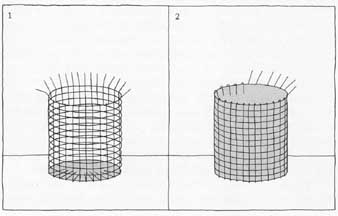
1. To make an inexpensive substitute for a tub, use plastic-coated garden fencing with a 1-by-2 -inch mesh, cutting it and curling it to the diameter you need. Wire the edges together. Bend the cut edges at the bottom inward.
2. Cut a circular bottom for the cylinder from hardware cloth, a wire mesh fine enough to hold soil but open enough to permit drainage. Line the sides of the cylinder with black roofing paper. With pliers, bend down the cut edges at the top of the cylinder to secure the paper. Fill the tub with potting soil; set in the plant as you do so. Be sure the heavy tub is placed where it’s to remain.
===
Hybridizers quickly learn to take every precaution in propagating the progeny of their controlled matings. Hybrid seeds are no harder to start than any other, but the more that sprout the greater the choice in selecting new plants. The techniques used to start precious hybrid seeds are equally useful when the object is not the breeding of new kinds of flowers but simply propagating plants.
HELPING SEEDS GERMINATE
To begin, make sure container and soil are sterile. Scrub the container with laundry bleach, one part liquid bleach to nine parts water. To make a starting soil mixture that will retain moisture without becoming waterlogged, mix equal parts of commercial pot ting soil and builder’s sand. Firm this mix in the container, then sprinkle the seed on top. Unless the seeds are very tiny, cover them to a depth of once or twice their diameter with starting mix. If possible, set the container in a pan of tepid water until the surface of the soil is moist. If that is not possible, make sure the starting mix is evenly moist before you plant the seed.
Some seeds need light to speed germination, others need to be shielded from the light, so it’s important to follow the instructions on the seed packet carefully. In both instances germination can be speeded with bottom heat, provided with a heating cable set at about 70 degrees under the containers or in the soil. (Once the seeds have germinated, the heat should be turned off.)
The secret of achieving a high level of germination is to keep the seed bed continuously moist. During the critical germination period this can be done by covering the container with plastic film or sliding it into a plastic bag, then setting it in the shade. In effect you are creating a moist, humid greenhouse within your green house. Be sure to remove the plastic the day that seedlings emerge; plants left under plastic grow spindly and soft.
Keep the tender seedlings in the warmest part of your green house, well shielded from drafts and abrupt temperature changes. To shelter them from the sun, suspend muslin over them to provide partial shade. When the second pair of true leaves emerges—leaves identifiable as those of the species—the seedlings are ready to be transplanted into individual containers.
HOW TO ROOT CUTTINGS
Greenhouse conditions are as helpful in other methods of propagation as they are in seed germination. The rooting medium in each case can be builder’s sand, peat moss, sphagnum moss, vermiculite, perlite, or a mixture of these; the goal is to combine water-holding capacity with good drainage and an open structure that lets air enter. Again, the rooting medium must be sterile.
Perhaps the simplest kind of propagation is by leaf cuttings, the way African violets are started. Cleanliness is vital. Sever the leaf, retaining an inch or so of the leafstalk to give it firm support, dip the cut end in hormone rooting powder, punch a hole in the rooting medium, insert half an inch of the leafstalk and firm the rooting medium around it. Leaf cuttings succeed almost as well with gloxinias, rex begonias, hoya, peperomias and many succulents. Keep the humidity high and shield the leaf from direct sunlight until roots form, which may take three or four weeks.
====
AN APPLE TREE TO GROW IN A GREENHOUSE
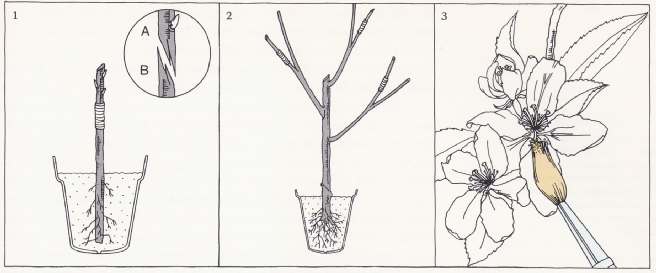
In early spring, plant in a pot a “dwarfing rootstock” for grafting from an apple-tree nursery. Cut a young branch from a tree of a desired apple variety. Slice matching clefts (inset), bind them and seal with wax.
In the early spring of the second year graft several branches of a different variety onto the first to provide the different blooms needed for fruiting. The next winter, keep the tree between 20 degrees and 40 degrees four months.
In the third spring, use an artist’s brush to transfer pollen from blossoms of one variety to the stigmas of another variety. Apples will be ready to pick in four months. Chill every winter thereafter and pollinate each spring.
====
The giant leaves of the rex begonia can be induced to bring forth new leaves with a touch of surgery. Lay a leaf on the rooting medium and make two or three cuts across its main veins. Secure it to the soil with toothpicks or hairpins, or weight it down with pebbles. In a few weeks, new plants will emerge from these cuts.
Small pieces of a plant’s roots can also be propagated, though the time required is longer. Woody vines like wisteria and bitter sweet respond well, as do perennials like bleeding heart, babies’- breath and phlox. Dig a vigorous root in the late summer, cut it into 2- or 3-inch lengths with a sharp knife, and plant the cuttings horizontally, ½ to 1 inch deep, in rooting medium. Keep the medium moist, and by spring you will have new plants.
The commonest method of vegetative propagation is by stem cuttings. With little effort, you can multiply any favorite variety or a new hybrid of such plants as geraniums, gardenias, wax begonias or fuchsias until they flood your greenhouse. Take cuttings of new growth 3 or 4 inches long in spring or summer, severing them just below leaf nodes with a sharp knife. Dip the cut ends into rooting powder and insert in the rooting medium. Remove only those leaves that would otherwise be buried and rot. Keep moist, humid and shielded from the sun until the roots form.
====
CROPS FOR A GOURMET
A surprising variety of miniature vegetables can be raised out of season in a greenhouse. Seed catalogues list numerous dwarf species of cabbage, cantaloupe, carrots, corn, cucumbers, eggplant, lettuce, peas, squash, tomatoes and watermelon. Midget corn , for example, grows only 3 feet high and takes 65 days to produce ears about 4 inches long and 1½ inches in diameter in general, the midget versions require the same growing conditions as their full-scale relatives, and even take the same time to reach maturity.
===
A technique called misting has all but revolutionized the propagation of stem cuttings that once were very difficult to root, including azaleas, camellias, jasmine, roses, holly, and even spruces and pine. All you need is a misting nozzle and timer, available at horticultural supply houses. With this equipment you can keep cuttings constantly moist by spraying them intermittently according to a preset schedule: For example, 10 seconds on and 90 seconds off through the daylight hours. A 24-hour timer, to turn the device on in the morning and off at night, is convenient but not essential.
Misting speeds rooting because the cooled cuttings can be kept in direct sunlight without either cooking or drying out, while the leaves continue to manufacture a maximum amount of food. Secure the spray head two or three feet above the cuttings and provide a drain for runoff. To keep the rest of the greenhouse from getting too humid, some gardeners enclose the misting operation in a hut framed with wood and covered with plastic film.
There is still another way to propagate: by grafting, that is, affixing plants onto host plants. Grafting is the only way that many desirable plants—including many special forms of evergreens like blue spruces and weeping hemlocks—can be propagated. Plants to be grafted should be related—a graft of one variety onto another is usually successful; almost all grafting of species will also work; graftings at the genus level work less often but are not rare.
PROPAGATING WITH GRAFTS
In grafting, the plant that is the host to the graft and supplies the root system is called the understock; the desired variety to be grafted on is the scion. Union between the two is accomplished by cutting and binding them to bring into close contact their cambium layers—the living growth tissue between the bark and the wood. Successful grafting requires clean cuts with a very sharp knife, careful matching of cambium layers, snug fastening and protection with grafting wax to prevent the tissues from drying out.
Most fine new roses are propagated by a special grafting technique known as budding. Take a dormant stalk in winter from the rose you want to duplicate; that is the scion. As the host, or understock, use a strong rose growing vigorously in your green house. With a sterile, sharp knife, make a T-shaped incision in the bark of the host just above ground level. Next, slice a single dormant bud from the scion, with half an inch of bark attached above and below it, cutting deeply enough to include a sliver of wood. Open the incision with the knife and insert the bud under the flaps, cut side inward. Close the flaps and wrap the incision with rubber bands, leaving only the bud exposed. After a week in the warmth of the greenhouse, the previously dormant bud should swell, indicating that all is well with the graft. If the binding does not disintegrate shortly, cut it loose.
When growth from the bud is well under way, prune the new growing stalk as necessary to force branching. Then cut away all stems of the host. Soon you will have a new rose, with roots of one kind and flower-bearing canes of another.
Should you be anxious to achieve early flowering of seedling roses you can do so with another type of grafting particularly suited to greenhouse work, known as approach grafting. In this case both plants remain attached to their roots, usually in separate pots, while the graft is made. About an inch of bark is sliced from a cane of the seedling rose and the same amount from a vigorously growing rose, then the cuts are bound together so the cambium layers match. When the union is accomplished, the seedling is severed just below the joint, leaving its cane growing on the older rose.
INVENTING A CACTUS
Cacti are among the most popular plants for greenhouse grafting because several different-looking types can be joined to create unusual effects. The ones that have colorful globular tops are all the result of grafts; these tops lack chlorophyll and could not survive on their own roots. Usually they are grafted onto an under- stock of columnar Trichocereus. To make such a graft, slice off the top of the understock, then cut a shallow V across the top just deep enough to accommodate the matching wedge-shaped base of the scion, then bind with thread or plant ties.
Such legerdemain makes Ultimate Greenhouse Gardening an opportunity for adventure. Some amateur breeders try to produce day lily blossoms that will last more than the one day that gives the flower its name. Others seek natural mutations—the chance appearance of a new type—that they can nourish and propagate. And in the professionals’ laboratories, experiments are leading to new ways to produce better plants—drugs and radiation treatments that force growth or stimulate genetic changes, even methods of fusing cells to generate combination plants previously undreamed of. It’s conceivable, said one scientist, that cell fusion might create an egg plant potato. “We might well add to that mix tomatoes and peppers,” he added. “They are all in the same family, you know.” The result, presumably, would be a one-plant source of vegetable stew.
== Oases of green designed to be lived in ==
The imaginative gardeners pictured use their greenhouses not just as plant laboratories but also as living spaces in which to read, eat, paint, swim, watch television, entertain or even, as young Michael Scherer demonstrates in the photograph, bathe. The Scherer greenhouse flows from the bathroom proper through sliding glass doors into a rectangle measuring 8 by 12 feet that was formerly a second-floor deck. Never remaining the same for very long, its horticultural contents rotate between green house and house because the Scherers like to decorate their home with living plants. When the plants need perking up, they are returned to the greenhouse, which functions rather like a plant hospital for its physician-owner.
Dr. Martin Scherer can devote to his greenhouse an average of 10 to 12 hours a week, mostly at night, and he designed it for minimal upkeep. An insulated floor and double-glazed roof and walls enable him to keep daytime temperatures at a constant 70° with only a single electric floor heater. Because his home is in a woodland setting, vulnerable to damage from falling tree limbs, the roof and walls of his greenhouse are made of the high-impact plastic that is used for airplane windshields.
Owners of other live-in greenhouses, faced with the problem of maintaining temperatures that are suitable to humans as well as plants, have resorted to a variety of solutions—depending upon the site, the climate and the cost of heating fuel. The Massachusetts gardeners shown conserve heat in their greenhouse with a roof made of two layers of plastic. On --, the owner of a greenhouse with a swimming pool uses supplementary heat from the water in the pool, which is kept between 70° and 80°, and from a freestanding fireplace. And in Minnesota, where winter temperatures frequently plummet far below zero, the owners of a greenhouse that doubles as an artist’s studio depend on a southern exposure coupled with three gas-fired heaters to keep their oasis green and comfortable.
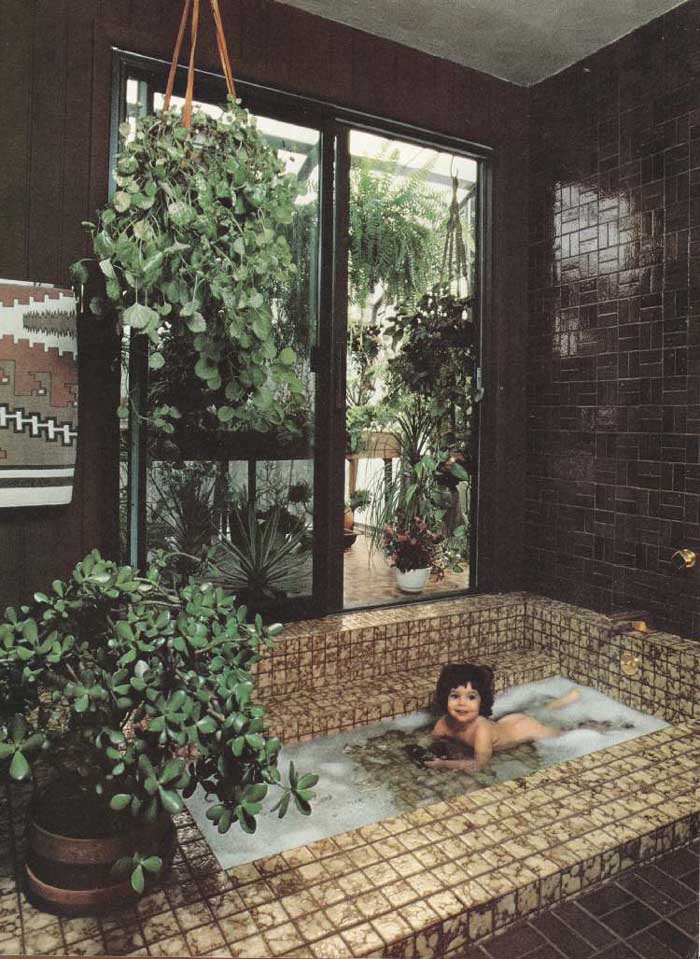
Young Michael Scherer bathes in privacy, thanks to his father’s greenhouse. Even when the trees are bare, the many plants hide the bathroom from the neighbor’s view.
== Moving in with the plants ==
What had been an open porch and grassy patio in a Boston suburb was enclosed in order to create this spectacular greenhouse, 40 feet long by 24 feet wide, where plants grow directly in the ground around a flagstoned seating area. With a small pool and waterfall, a fireplace (built into the house wall) and television, the greenhouse provides a garden that is a comfortable year-round living room; its owners, the Winthrop Bakers, are “always out there.”
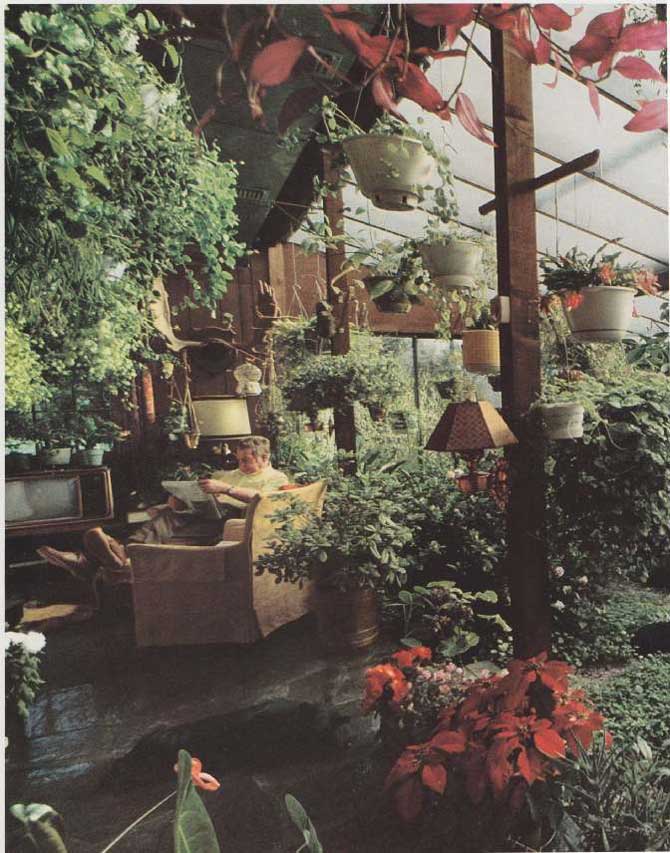
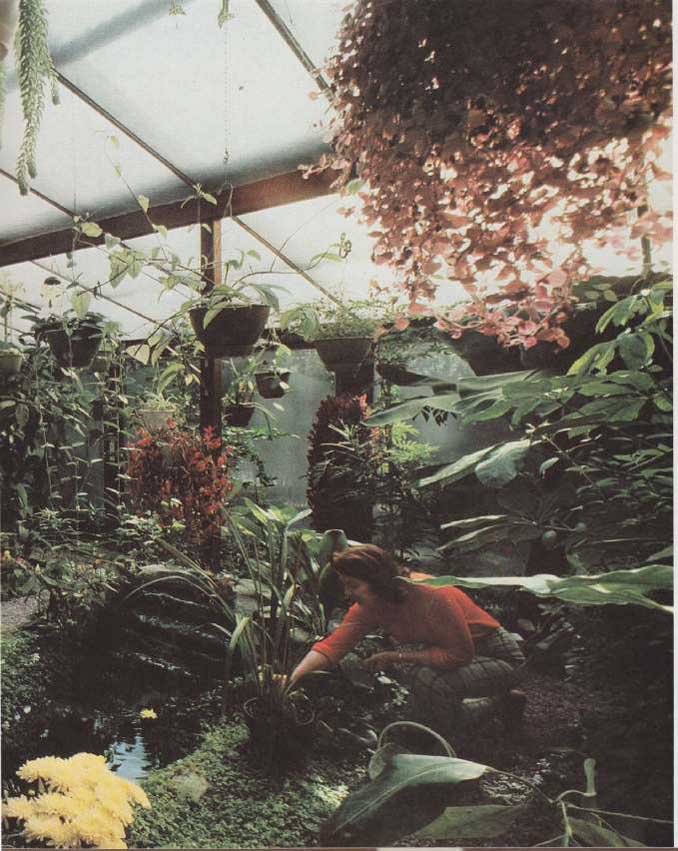
Winthrop Baker reads as his wife Priscilla tends the greenhouse constructed from a porch to her specifications. Baker, a professional builder, installed a heating duct along a section of the former porch roof (top left). Louvers in the duct are adjustable and can be slanted to direct the heat as needed.
== Art amid the greenery ==
When the temperature in Minnesota dips as low as -30°, Carol Ann Mackay’s lean-to greenhouse remains a comfortable 70 degrees, warm enough for Mrs. Mackay, a professional artist, to use as a studio. It offers space not only for her work but, on benches of two depths, room to grow vegetables, to force chrysanthemums from her garden into an extra flowering cycle, and to raise both annuals and perennials for winter cut flowers, “my greatest luxury.”
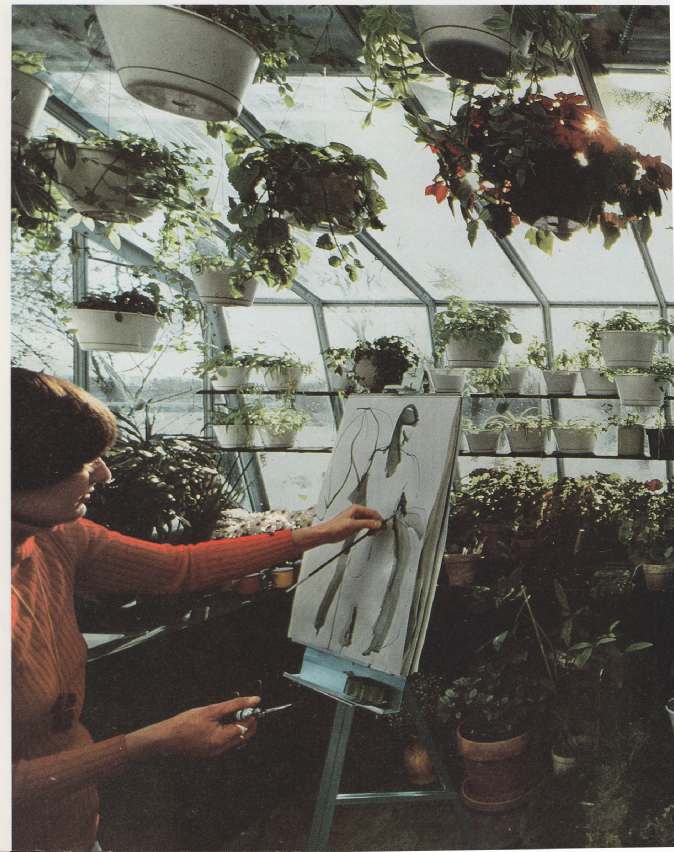
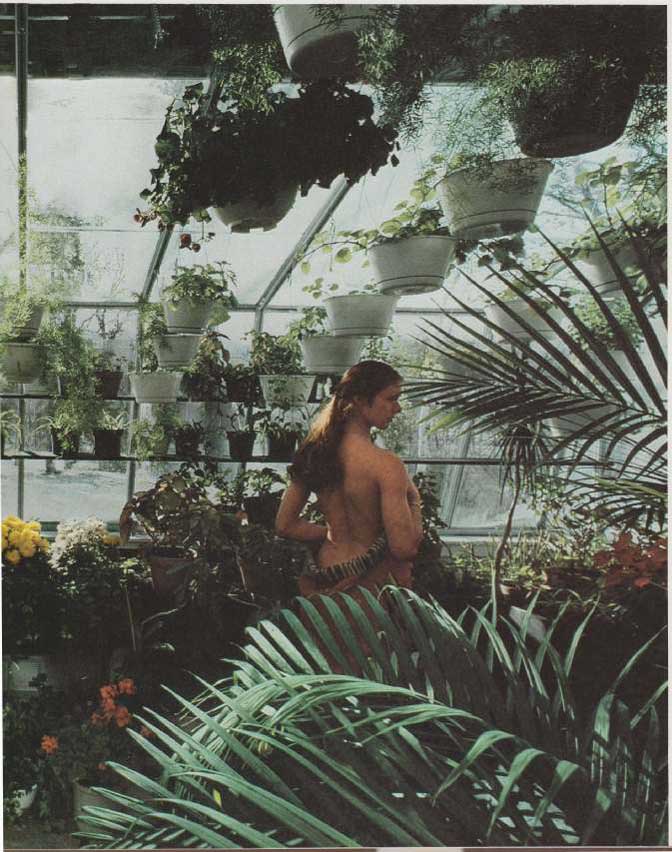
Framed by the arching fronds of a butterfly palm, a model poses for a brush-and-ink nude in the Mackay greenhouse. At night the temperature may drop to 50 degrees F; many of the plants grown here are species requiring warm days and cool nights.
== A tropical paradise ==
A heated swimming pool helps to keep this 50-year-old greenhouse humid for its tropical foliage plants. Transplanted from an estate to suburban New York City by its present owner, interior landscape designer Roger Wohrle, the freestanding glass-and-steel structure measures 35 by 93 feet; its peak is high enough to accommodate trees 15 feet tall. The owner, who frequently entertains in his greenhouse, claims that “40 people can easily get lost in it.”


Seated near a conical fireplace, Wohrle entertains in a tropical paradise of vines, trees, ferns and orchids. To make the setting seem more natural, heating pipes are concealed beneath the greenhouse benches or screened by banks of plants — among which hop live crickets, frogs and tree toads.
Articles in this Guide are based on now-classic Time-Life Encyclopedia of Gardening Series from the 1970s ... a timeless series, some titles of which are still available in libraries and bookstores... see our Amazon Store for purchasing options.
Prev. | Next